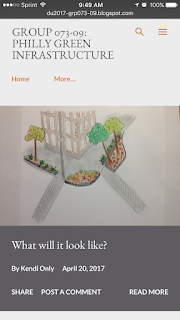Below are some photos of our progress!
What are they: “A stormwater bumpout is a vegetated curb extension that protrudes into the street either mid-block or at an intersection, creating a new curb some distance from the existing curb. A bumpout is composed of a layer of stone that is topped with soil and plants. An inlet or curb-cut directs runoff into the bumpout structure where it can be stored, infiltrated, and taken up by the plants (evapotranspiration). Excess runoff is permitted to leave the system and flow to an existing inlet. The vegetation of the bumpout will be short enough to allow for open sight lines of traffic. Aside from managing stormwater, bumpouts also help with traffic-calming, and when located at crosswalks, they provide a pedestrian safety benefit by reducing the street crossing distance.” Advantages/Benefits: -shorten crossing distances on streets (safer for pedestrians) -gives perception of road narrowing so drivers slow down in this area -reduce stormwater overflow -add curb a...




Comments
Post a Comment